The Time Lag Effects and Interaction among Climate, Soil Moisture, and Vegetation from In Situ Monitoring Measurements across China
Abstract
:1. Introduction
2. Materials and Methods
2.1. Study Area and In Situ Monitoring Network
2.2. Data Source
2.3. Methodology
2.3.1. Pre-Processing and Quality Control of In Situ Monitoring SM Dataset
- —the meteorological or LAI value after adjacent site/grid interpolation;
- —the LAI or meteorological value at the jth neighboring site/grid;
- —the distance between the jth neighboring site/grid and the SM site;
- nn—the number of neighboring sites/grids.
2.3.2. Time-Lagged Anomaly Correlation
2.3.3. Cross-Wavelet Transform (XWT) Method
- , —the continuous wavelet transforms of two time series;
- , —the background power spectra;
- , —the standard deviation of An and Bn;
- —the confidence level of probability p.
3. Results
3.1. Spatial Distribution and Temporal Characteristics of Soil Moisture for four Soil Layers
3.2. Time Lag and Accumulation Effects among Climate, Vegetation, and Soil Moisture
3.2.1. Climate–SM Interaction and Time Lag Effects
3.2.2. Climate–LAI Interaction and Time Lag Effects throughout Four Climate Zones
3.2.3. SM–LAI Interaction and Time Lag Effects in Different Layers and Climate Zones
3.3. Impacts of Teleconnection Factors on Vegetation and Soil Moisture
3.3.1. Dynamic Relation between Teleconnection Factors and LAI
3.3.2. Response in SM Dynamics to Large-Scale Climatic Factors
4. Discussion
4.1. Annual Variation of SM and Main Driving Factors
4.2. Interaction Effects between Vegetation and Soil Moisture Dynamics
4.3. Limitations and Uncertainty Analysis
- (1)
- Observation errors: This refers to the data errors caused by the subjective factors of manual operation or objective monitoring equipment.
- (2)
- Data continuity: Collecting soil data in winter can be challenging due to low temperatures in the north and the impact of soil freezing. As a result, many stations lack observation data during this season.
- (3)
- Spatial consistency: Achieving consistency in the integrated data from each manual monitoring site is challenging due to variations in operation and management methods across different departments and practical units.
- (4)
- Impact of agriculture: The location of monitoring stations, particularly in the semi-arid and semi-humid zones, is crucial for agricultural production in China. Agricultural irrigation, which has not been accounted for in this study, may have impacted the SM dynamics. Future analysis could be conducted to investigate this.
- (5)
- Layered soil data: The datasets consist of SM measurements at depths of 0–40 cm. However, there is a lack of data for the third layer and no monitoring data for deeper SM. Matching the distribution of root depth would improve the analysis of the dynamic relationship between vegetation and SM. Deep SM-monitoring networks or estimating methods for the root–surface relationship can be improved in the future [45,46].
- (6)
- SM observation stations can monitor soil water dynamics at a single point, but their representativeness is limited due to the spatial heterogeneity of underlying factors [47]. In the future, the quality of SM data products can be improved by combining remote sensing detection technology, scale conversion methods, and data fusion technology [48]. This will provide new impetus for exploring hydrological processes in river basins.
5. Conclusions
- (1)
- In China, SM tends to become wetter from northwest to southeast, with a water weight of approximately 15–25 g per 100 g of soil. The surface SM exhibits the greatest variation. The annual variation of SM follows a phased change pattern in response to P, T, and vegetation growth.
- (2)
- The response of surface SM to climate change is most sensitive. SM is negatively correlated with T and SD, while it is positively correlated with P and Hum. The response time of SM to climate factors varies. SM is more sensitive to water vapor conditions in the arid zone, while the humid zone is most sensitive to heat quantity.
- (3)
- The relationships for the LAI leading SM (negative correlation) and SM leading the LAI (positive correlation) exhibit opposite properties. This is more significant in the arid and semi-arid zones, with a response time of 2~4 months between the LAI and SM. The interaction between the LAI and SM is more pronounced in deep layers in the arid zone, while it is more pronounced in surface layers in humid areas, which is related to the depth distribution of vegetation roots.
- (4)
- The NAO has the greatest impact on the LAI in the arid and semi-arid zones (mainly in winter and summer), while the AAO does in the semi-humid and humid zones (in spring and summer). There is a main influence period for about 8–16 months between teleconnection factors and the LAI. The NAO and AO have a greater impact on SM in the humid region, while the ENSO and NAO do on SM in the arid zone.
Author Contributions
Funding
Data Availability Statement
Conflicts of Interest
References
- Bowen, G. The diversified economics of soil water. Nature 2015, 525, 43–44. [Google Scholar] [CrossRef]
- Vereecken, H.; Amelung, W.; Bauke, S.; Bogena, H.; Brüggemann, N.; Montzka, C.; Vanderborght, J.; Bechtold, M.; Blöschl, G.; Carminati, A.; et al. Soil hydrology in the Earth system. Nat. Rev. Earth Environ. 2022, 3, 573–587. [Google Scholar] [CrossRef]
- Dong, J.; Akbar, R.; Gianotti, D.; Feldman, A.; Crow, W.; Entekhabi, D. Can Surface Soil Moisture Information Identify Evapotranspiration Regime Transitions? Geophys. Res. Lett. 2022, 49, e2021GL097697. [Google Scholar] [CrossRef]
- Zhu, L.; Yang, M.; Liu, J.; Zhang, Y.; Chen, X.; Zhou, B. Evolution of the freeze-thaw cycles in the source region of the Yellow River under the influence of climate change and its hydrological effects. J. Ground. Sci. Eng. 2022, 10, 322–334. [Google Scholar]
- Guan, Y.; Gu, X.; Slater, L.; Li, J.; Kong, D.; Zhang, X. Spatio-temporal variations in global surface soil moisture based on multiple datasets: Intercomparison and climate drivers. J. Hydrol. 2023, 625, 130095. [Google Scholar] [CrossRef]
- Liu, Z.; Notaro, M.; Gallimore, R. Indirect vegetation-soil moisture feedback with application to Holocene North Africa climate. Glob. Change Biol. 2010, 16, 1733–1743. [Google Scholar] [CrossRef]
- Nigenare, A.; Meng, Y.; Wang, J.; Ge, X.; Tang, Z. Climate overtakes vegetation greening in regulating spatiotemporal patterns of soil moisture in arid Central Asia in recent 35 years. GISci. Remote Sens. 2024, 61, 2286744. [Google Scholar] [CrossRef]
- Zhu, Z.; Piao, S.; Myneni, R.; Huang, M.; Zeng, Z.; Canadell, J.; Ciais, P.; Sitch, S.; Friedlingstein, P.; Arneth, A. Greening of the Earth and its drivers. Nat. Clim. Change 2016, 6, 791. [Google Scholar] [CrossRef]
- Qin, G.; Meng, Z.; Fu, Y. Drought and water-use efficiency are dominant environmental factors affecting greenness in the Yellow River Basin, China. Sci. Total Environ. 2022, 834, 155479. [Google Scholar] [CrossRef]
- Wang, C.; Chen, J.; Gu, L.; Wu, G.; Tong, S.; Xiong, L.; Xu, C. A pathway analysis method for quantifying the contributions of precipitation and potential evapotranspiration anomalies to soil moisture drought. J. Hydrol. 2023, 621, 129570. [Google Scholar] [CrossRef]
- Romano, N. Soil moisture at local scale: Measurements and simulations. J. Hydrol. 2014, 516, 6–20. [Google Scholar] [CrossRef]
- Han, Z.; Huang, Q.; Huang, S.; Leng, G.; Bai, Q.; Liang, H.; Wang, L.; Zhao, J.; Fang, W. Spatial-temporal dynamics of agricultural drought in the Loess Plateau under a changing environment: Characteristics and potential influencing factors. Agric. Water Manag. 2021, 244, 106540. [Google Scholar] [CrossRef]
- Li, W.; Wang, Y.; Yang, J.; Deng, Y. Time-Lag Effect of Vegetation Response to Volumetric Soil Water Content: A Case Study of Guangdong Province, Southern China. Remote Sens. 2022, 14, 1301. [Google Scholar] [CrossRef]
- Li, S.; Sawada, Y. Soil moisture-vegetation interaction from near-global in-situ soil moisture measurements. Environ. Res. Lett. 2022, 17, 114028. [Google Scholar] [CrossRef]
- Wu, D.; Zhao, X.; Liang, S.; Zhou, T.; Huang, K.; Tang, B.; Zhao, W. Time-lag effects of global vegetation responses to climate change. Glob. Change Biol. 2015, 21, 3520–3531. [Google Scholar] [CrossRef]
- Xu, S.; Wang, Y.; Liu, Y.; Li, J.; Qian, K.; Yang, X.; Ma, X. Evaluating the cumulative and time-lag effects of vegetation response to drought in Central Asia under changing environments. J. Hydrol. 2023, 627, 130455. [Google Scholar] [CrossRef]
- Yu, T.; Bao, A.; Zhang, J.; Tu, H.; Chen, B.; De Maeyer, P.; Van de Voorde, T. Evaluating surface soil moisture characteristics and the performance of remote sensing and analytical products in Central Asia. J. Hydrol. 2023, 617, 128921. [Google Scholar] [CrossRef]
- Xu, L.; Gao, G.; Wang, X.; Fu, B. Distinguishing the effects of climate change and vegetation greening on soil moisture variability along aridity gradient in the drylands of northern China. Agric. For. Meteorol. 2023, 343, 109786. [Google Scholar] [CrossRef]
- Kong, D.; Miao, C.; Wu, J.; Zheng, H.; Wu, S. Time lag of vegetation growth on the Loess Plateau in response to climate factors: Estimation, distribution, and influence. Sci. Total Environ. 2020, 744, 140726. [Google Scholar] [CrossRef]
- Feng, Y.; Wang, H.; Liu, W.; Sun, F. Global Soil Moisture-Climate Interactions during the Peak Growing Season. J. Clim. 2023, 36, 1187–1196. [Google Scholar] [CrossRef]
- Konkathi, P.; Karthikeyan, L. Utility of L-band and X-band vegetation optical depth to examine vegetation response to soil moisture droughts in South Asia. Remote Sens. Environ. 2023, 301, 113933. [Google Scholar] [CrossRef]
- Babaeian, E.; Sadeghi, M.; Jones, S.; Montzka, C.; Vereecken, H.; Tuller, M. Ground, Proximal, and Satellite Remote Sensing of Soil Moisture. Rev. Geophys. 2019, 57, 530–616. [Google Scholar] [CrossRef]
- Stillman, S.; Zeng, X. Evaluation of SMAP Soil Moisture Relative to Five Other Satellite Products Using the Climate Reference Network Measurements Over USA. IEEE Trans. Geosci. Remote Sens. 2018, 56, 6296–6305. [Google Scholar] [CrossRef]
- Yang, Y.; Zhang, J.; Bao, Z.; Ao, T.; Wang, G.; Wu, H.; Wang, J. Evaluation of multi-source soil moisture datasets over central and eastern agricultural area of China using in situ monitoring network. Remote Sens. 2021, 13, 1175. [Google Scholar] [CrossRef]
- Chen, C.; Park, T.; Wang, X.; Piao, S.; Xu, B.; Chaturvedi, R.; Fuchs, R.; Brovkin, V.; Ciais, P.; Fensholt, R.; et al. China and India lead in greening of the world through land-use management. Nat. Sustain. 2019, 2, 122–129. [Google Scholar] [CrossRef] [PubMed]
- Dou, Y.; Tong, X.; Horion, S.; Feng, L.; Fensholt, R.; Shao, Q.; Tian, F. The success of ecological engineering projects on vegetation restoration in China strongly depends on climatic conditions. Sci. Total Environ. 2024, 915, 170041. [Google Scholar] [CrossRef] [PubMed]
- Ma, L.; Cui, Y.; Liu, B.; Liao, B.; Wei, J.; Han, H.; Tian, W. A GIS-based method for modeling methane emissions from paddy fields by fusing multiple sources of data. Sci. Total Environ. 2022, 859, 159917. [Google Scholar] [CrossRef] [PubMed]
- Zhang, Y.; Kong, D.; Gan, R.; Chiew, F.; McVicar, T.; Zhang, Q.; Yang, Y. Coupled estimation of 500 m and 8-day resolution global evapotranspiration and gross primary production in 2002–2017. Remote Sens. Environ. 2019, 222, 165–182. [Google Scholar] [CrossRef]
- Grinsted, A.; Moore, J.; Jevrejeva, S. Application of the cross wavelet transform and wavelet coherence to geophysical time series. Nonlinear Process. Geophys. 2004, 11, 561566. [Google Scholar] [CrossRef]
- Wang, F.; Lai, H.; Li, Y.; Feng, K.; Tian, Q.; Guo, W.; Qu, Y.; Yang, H. Spatio-temporal evolution and teleconnection factor analysis of groundwater drought based on the GRACE mascon model in the Yellow River Basin. J. Hydrol. 2023, 626, 130349. [Google Scholar] [CrossRef]
- Hauser, E.; Sullivan, P.; Flores, A.; Hirmas, D.; Billings, S. A Global-scale shifts in rooting depths due to anthropocene land cover changes pose unexamined consequences for critical zone functioning. Earth Future 2022, 10, e2022EF002897. [Google Scholar] [CrossRef]
- Li, B.; Zhang, W.; Li, S.; Wang, J.; Liu, G.; Xu, M. Severe depletion of available deep soil water induced by revegetation on the arid and semiarid Loess Plateau. For. Ecol. Manag. 2021, 491, 119156. [Google Scholar] [CrossRef]
- Li, M.; Wu, P.; Ma, Z.; Pan, Z.; Lv, M.; Yang, Q.; Duan, Y. The Increasing Role of Vegetation Transpiration in Soil Moisture Loss across China under Global Warming. J. Hydrometeorol. 2022, 23, 253–274. [Google Scholar] [CrossRef]
- Dong, L.; Fu, C.; Liu, J.; Zhang, P. Combined Effects of Solar Activity and El Nio on Hydrologic Patterns in the Yoshino River Basin, Japan. Water Resour. Manag. 2018, 32, 2421–2435. [Google Scholar] [CrossRef]
- Zhao, J.; Huang, S.Z.; Huang, Q. Time-lagged response of vegetation dynamics to climatic and teleconnection factors. Catena 2020, 189, 104474. [Google Scholar] [CrossRef]
- Lin, Q.; Wu, Z.; Singh, V.; Sadeghi, S.; He, H.; Lu, G. Correlation between hydrological drought, climatic factors, reservoir operation, and vegetation cover in the Xijiang Basin, South China. J. Hydrol. 2017, 549, 512–524. [Google Scholar] [CrossRef]
- Zwieback, S.; Colliander, A.; Cosh, M.; Martínez-Fernándezj, J.; McNairn, H.; Starks, P.; Thibeault, M.; Berg, A. Estimating time-dependent vegetation biases in the SMAP soil moisture product. Hydrol. Earth Syst. Sci. 2018, 22, 4473–4489. [Google Scholar] [CrossRef]
- Liu, Y.; Yang, Y. Spatial-temporal variability pattern of multi-depth soil moisture jointly driven by climatic and human factors in China. J. Hydrol. 2023, 619, 129313. [Google Scholar] [CrossRef]
- Ding, Y.; Li, Z.; Peng, S. Global analysis of time-lag and-accumulation effects of climate on vegetation growth. Int. J. Appl. Earth Obs. 2020, 92, 102179. [Google Scholar] [CrossRef]
- Wen, Y.; Liu, X.; Xin, Q.; Wu, J.; Xu, X.; Pei, F.; Li, X.; Du, G.; Cai, Y.; Lin, K. Cumulative effects of climatic factors on terrestrial vegetation growth. J. Geophys. Res-Biogeo. 2019, 124, 789–806. [Google Scholar] [CrossRef]
- Ma, M.; Wang, Q.; Liu, R.; Zhao, Y.; Zhang, D. Effects of climate change and human activities on vegetation coverage change in northern China considering extreme climate and time-lag and -accumulation effects. Sci. Total Environ. 2023, 860, 160527. [Google Scholar] [CrossRef] [PubMed]
- Deng, Y.; Wang, S.; Bai, X.; Luo, G.; Wu, L.; Chen, F.; Wang, J.; Li, C.; Yang, Y.; Hu, Z.; et al. Vegetation greening intensified soil drying in some semi-arid and arid areas of the world. Agric. For. Meteorol. 2020, 292, 108103. [Google Scholar] [CrossRef]
- Neill, C.; Coe, M.T.; Riskin, S.H.; Krusche, A.; Elsenbeer, H.; Macedo, M.; McHorney, R.; Lefebvre, P.; Davidson, E.; Scheffler, R.; et al. Watershed responses to Amazon soya bean cropland expansion and intensification. Philos. Trans. R. Soc. B Biol. Sci. 2013, 368, 20120425. [Google Scholar] [CrossRef] [PubMed]
- Cao, J.; Tian, H.; Adamowski, J.; Zhang, X.; Cao, Z. Influences of afforestation policies on soil moisture content in China’s arid and semi-arid regions. Land Use Policy 2018, 75, 449–458. [Google Scholar] [CrossRef]
- Yang, Y.; Bao, Z.; Wu, H.; Wu, H.; Wang, G.; Liu, C.; Wang, J.; Zhang, J. An Exponential Filter Model-Based Root-Zone Soil Moisture Estimation Methodology from Multiple Datasets. Remote Sens. 2022, 14, 1785. [Google Scholar] [CrossRef]
- Baldwin, D.; Manfreda, S.; Keller, K.; Smithwick, E. Predicting root zone soil moisture with soil properties and satellite near-surface moisture data across the conterminous United States. J. Hydrol. 2017, 546, 393–404. [Google Scholar] [CrossRef]
- Yilmaz, M.; Crow, W.; Anderson, M.; Hain, C. An objective methodology for merging satellite- and model-based soil moisture products. Water Resour. Res. 2012, 48, W11502. [Google Scholar] [CrossRef]
- Gruber, A.; Scanlon, T.; Schalie, R.; Wagner, W.; Dorigo, W. Evolution of the ESA CCI soil moisture climate data records and their underlying merging methodology. Earth Syst. Sci. Data 2019, 11, 717–739. [Google Scholar] [CrossRef]
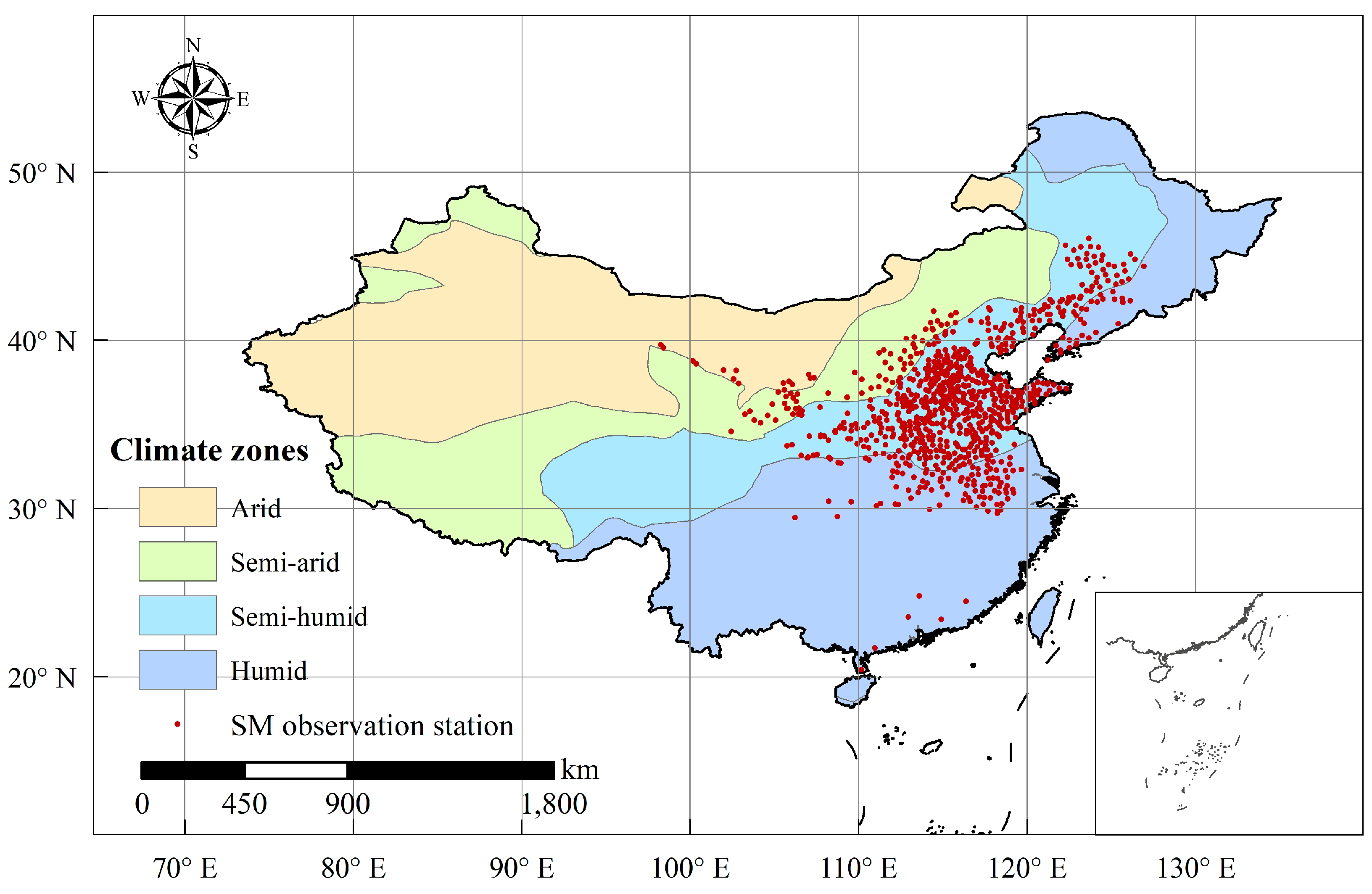


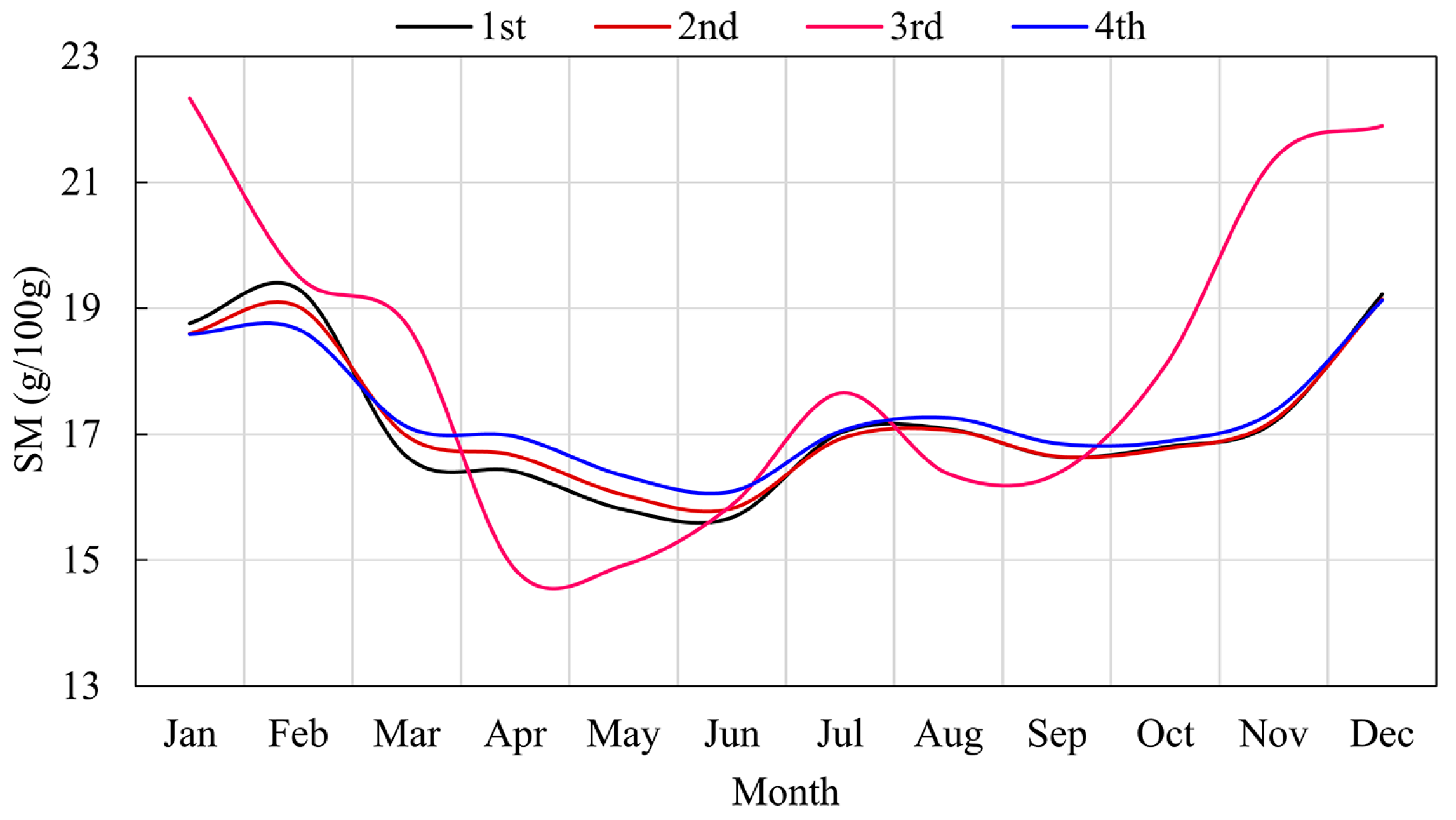
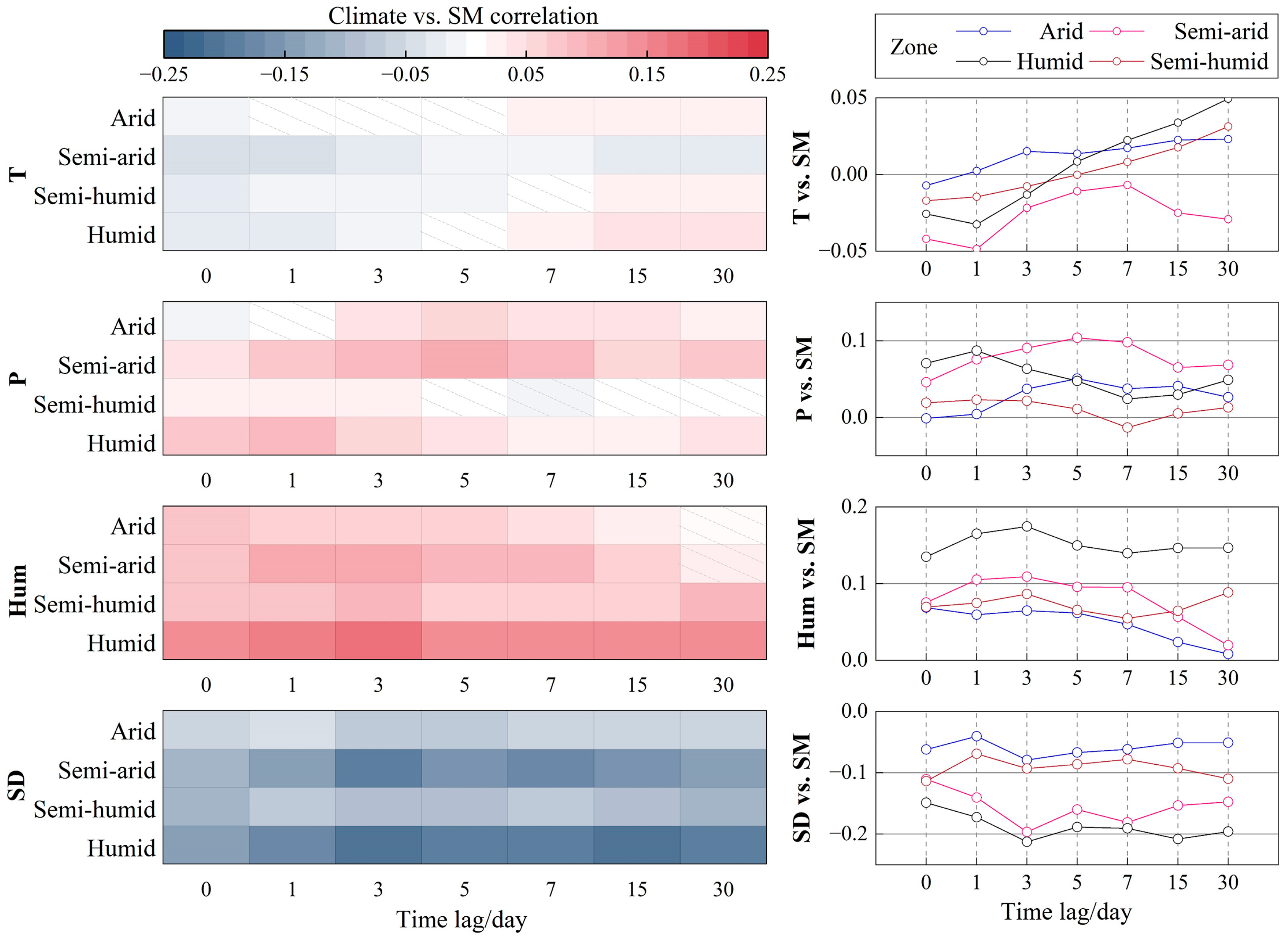
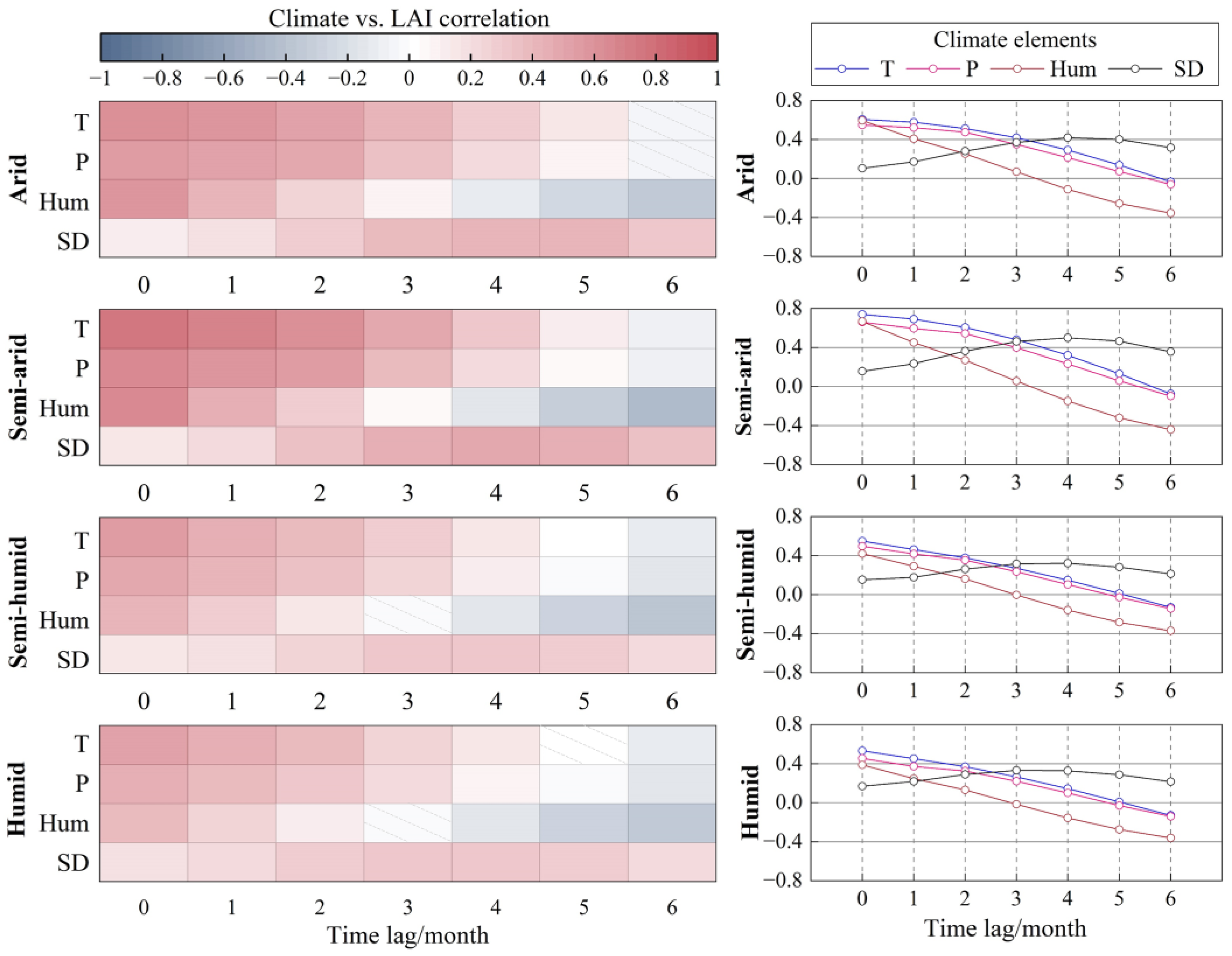
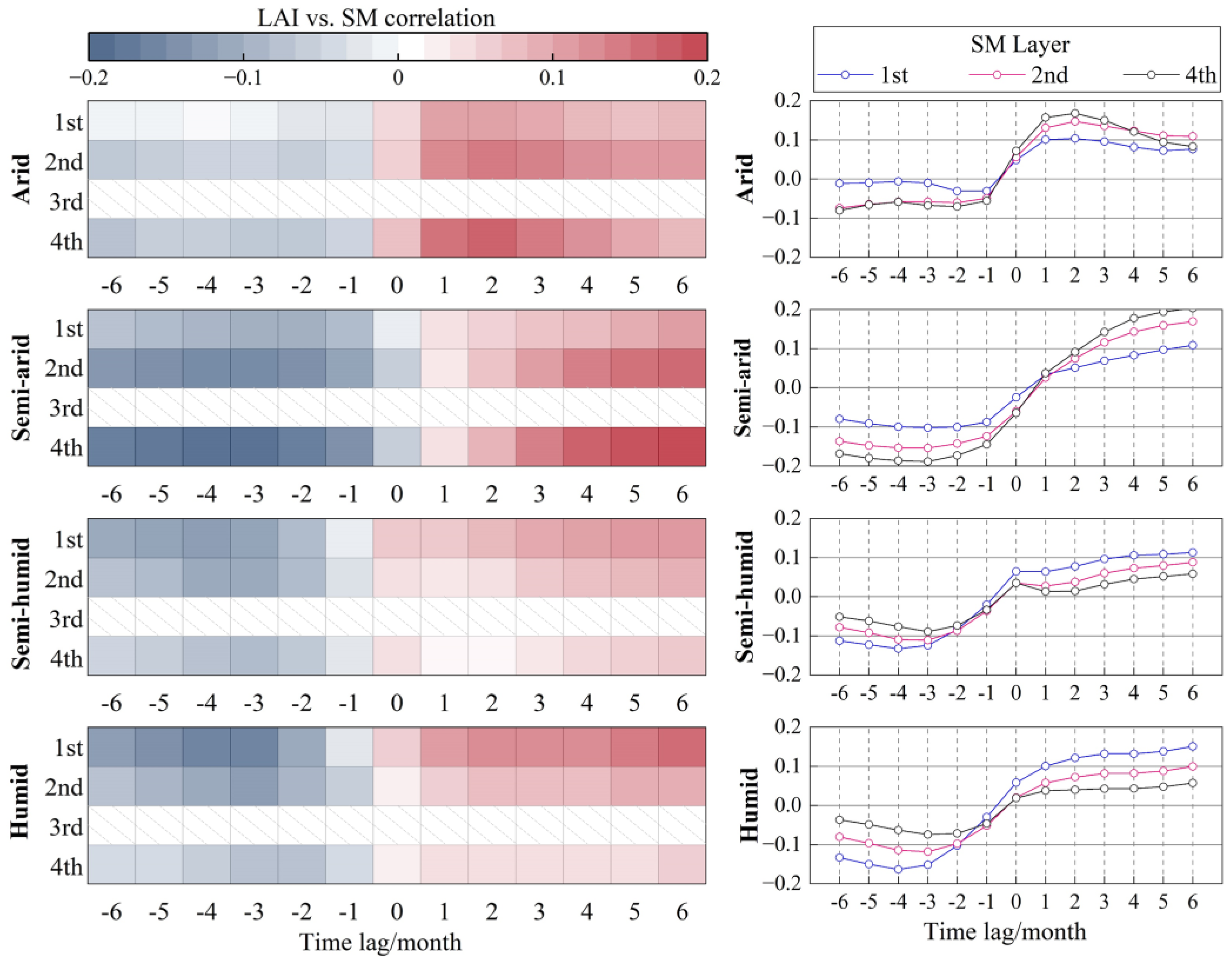



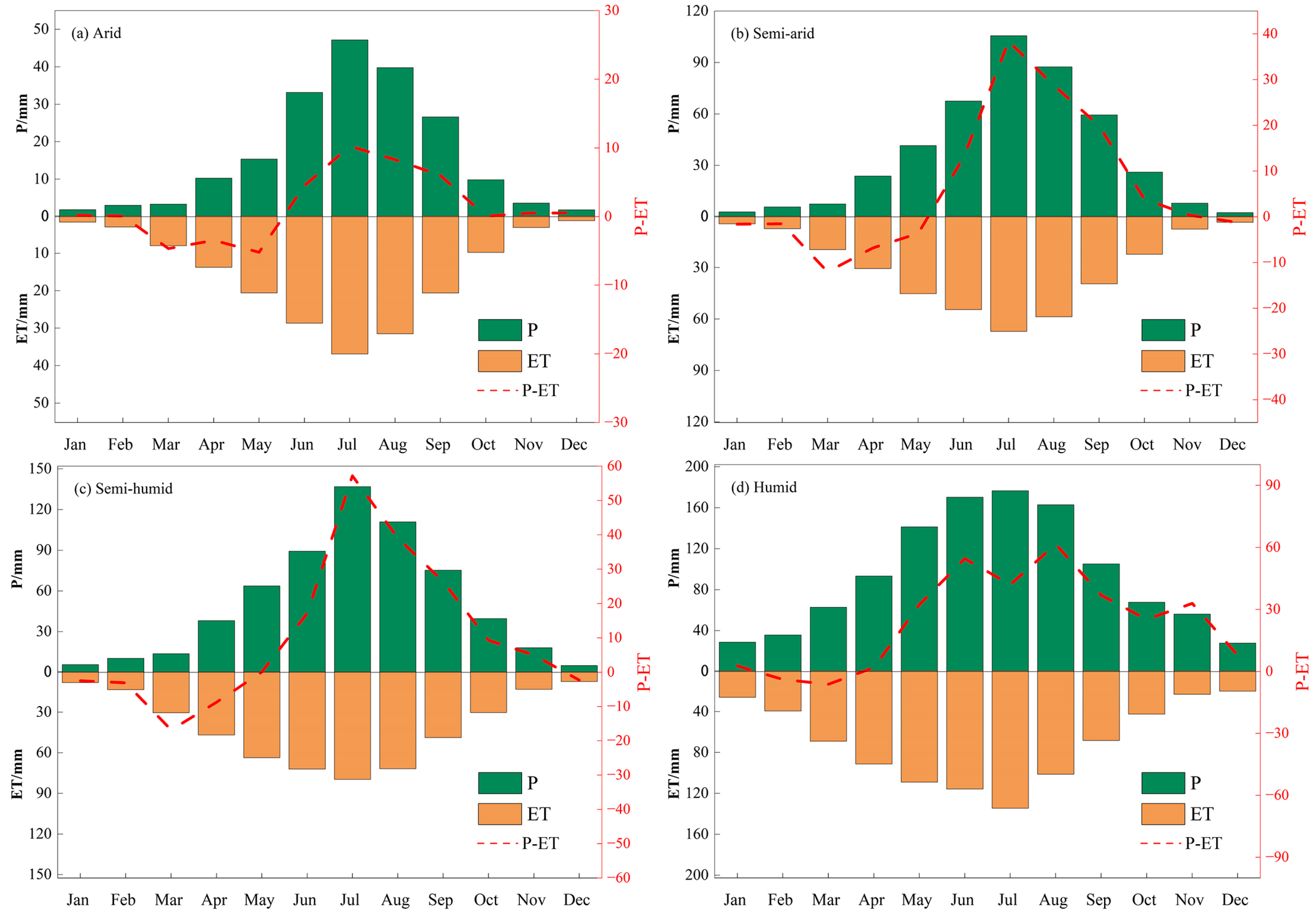
| Climate Zones | Site Name | Longitude | Latitude |
|---|---|---|---|
| Arid zone | Gaoshawo | 107.04 | 37.99 |
| Semi-arid | Mizhi | 110.20 | 37.70 |
| Semi-humid | Lvzhuang | 111.25 | 35.38 |
| Humid | Zhaowan | 112.16 | 33.12 |
| Climate Zone | Indices | Spring | Summer | Autumn | Winter | Mean |
|---|---|---|---|---|---|---|
| Arid | NAO | / | −0.314 | −0.297 | −0.397 | −0.255 |
| AO | / | 0.073 | −0.054 | −0.427 * | −0.138 | |
| AAO | / | 0.186 | 0.308 | −0.075 | 0.221 | |
| ENSO | / | −0.169 | −0.039 | −0.106 | −0.074 | |
| Semi-arid | NAO | 0.231 | −0.293 | −0.152 | −0.325 | −0.242 |
| AO | 0.013 | 0.158 | −0.064 | −0.539 ** | −0.166 | |
| AAO | 0.104 | 0.132 | 0.159 | −0.009 | 0.208 | |
| ENSO | −0.053 | −0.111 | −0.071 | −0.189 | −0.069 | |
| Semi-humid | NAO | 0.141 | −0.175 | −0.312 | −0.353 | −0.223 |
| AO | 0.043 | 0.038 | −0.080 | −0.546 ** | −0.174 | |
| AAO | 0.293 | 0.274 | 0.206 | −0.053 | 0.260 | |
| ENSO | 0.023 | 0.011 | 0.072 | −0.099 | −0.044 | |
| Humid | NAO | −0.034 | −0.170 | −0.315 | −0.424 * | −0.254 |
| AO | −0.019 | 0.156 | −0.106 | −0.528 ** | −0.198 | |
| AAO | 0.379 | 0.175 | 0.157 | 0.033 | 0.266 | |
| ENSO | 0.028 | −0.011 | 0.069 | 0.037 | −0.030 |
| SM | Zone | NAO | AO | AAO | ENSO |
|---|---|---|---|---|---|
| 1st | Arid | 0.280 * | −0.115 | −0.099 | 0.470 ** |
| Semi-arid | 0.208 * | 0.109 | −0.175 | 0.061 | |
| Semi-humid | 0.233 * | 0.234 * | −0.136 | −0.033 | |
| Humid | 0.115 | 0.119 | −0.024 | 0.145 | |
| 2nd | Arid | 0.401 ** | −0.031 | −0.130 | 0.566 ** |
| Semi-arid | 0.154 | 0.168 | −0.197 | 0.101 | |
| Semi-humid | 0.257 ** | 0.210 * | −0.122 | 0.028 | |
| Humid | 0.156 | 0.164 | −0.014 | 0.176 | |
| 4th | Arid | 0.101 | −0.188 | −0.127 | 0.584 ** |
| Semi-arid | 0.059 | 0.185 | −0.197 | 0.251 ** | |
| Semi-humid | 0.244 ** | 0.161 | −0.124 | 0.088 | |
| Humid | 0.145 | 0.166 | −0.014 | 0.193 |
Disclaimer/Publisher’s Note: The statements, opinions and data contained in all publications are solely those of the individual author(s) and contributor(s) and not of MDPI and/or the editor(s). MDPI and/or the editor(s) disclaim responsibility for any injury to people or property resulting from any ideas, methods, instructions or products referred to in the content. |
© 2024 by the authors. Licensee MDPI, Basel, Switzerland. This article is an open access article distributed under the terms and conditions of the Creative Commons Attribution (CC BY) license (https://creativecommons.org/licenses/by/4.0/).
Share and Cite
Wang, J.; Bao, Z.; Wang, G.; Liu, C.; Xie, M.; Wang, B.; Zhang, J. The Time Lag Effects and Interaction among Climate, Soil Moisture, and Vegetation from In Situ Monitoring Measurements across China. Remote Sens. 2024, 16, 2063. https://doi.org/10.3390/rs16122063
Wang J, Bao Z, Wang G, Liu C, Xie M, Wang B, Zhang J. The Time Lag Effects and Interaction among Climate, Soil Moisture, and Vegetation from In Situ Monitoring Measurements across China. Remote Sensing. 2024; 16(12):2063. https://doi.org/10.3390/rs16122063
Chicago/Turabian StyleWang, Jie, Zhenxin Bao, Guoqing Wang, Cuishan Liu, Mingming Xie, Bin Wang, and Jianyun Zhang. 2024. "The Time Lag Effects and Interaction among Climate, Soil Moisture, and Vegetation from In Situ Monitoring Measurements across China" Remote Sensing 16, no. 12: 2063. https://doi.org/10.3390/rs16122063






